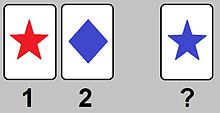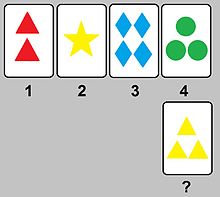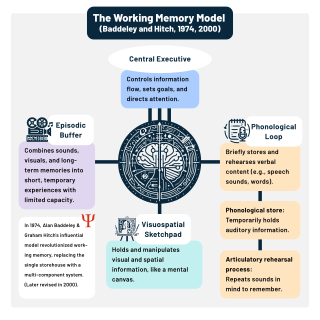
Working memory is a cognitive system with a limited capacity that can hold information temporarily. It is important for reasoning and the guidance of decision-making and behavior. Working memory is often used synonymously with short-term memory, but some theorists consider the two forms of memory distinct, assuming that working memory allows for the manipulation of stored information, whereas short-term memory only refers to the short-term storage of information. Working memory is a theoretical concept central to cognitive psychology, neuropsychology, and neuroscience.

Attention or focus, is the concentration of awareness on some phenomenon to the exclusion of other stimuli. It is the selective concentration on discrete information, either subjectively or objectively. William James (1890) wrote that "Attention is the taking possession by the mind, in clear and vivid form, of one out of what seem several simultaneously possible objects or trains of thought. Focalization, concentration, of consciousness are of its essence." Attention has also been described as the allocation of limited cognitive processing resources. Attention is manifested by an attentional bottleneck, in terms of the amount of data the brain can process each second; for example, in human vision, less than 1% of the visual input data stream of 1MByte/sec can enter the bottleneck, leading to inattentional blindness.
In psychology, theory of mind refers to the capacity to understand other people by ascribing mental states to them. A theory of mind includes the knowledge that others' beliefs, desires, intentions, emotions, and thoughts may be different from one's own. Possessing a functional theory of mind is crucial for success in everyday human social interactions. People utilize a theory of mind when analyzing, judging, and inferring others' behaviors. The discovery and development of theory of mind primarily came from studies done with animals and infants. Factors including drug and alcohol consumption, language development, cognitive delays, age, and culture can affect a person's capacity to display theory of mind. Having a theory of mind is similar to but not identical with having the capacity for empathy or sympathy.

In psychology, the Stroop effect is the delay in reaction time between congruent and incongruent stimuli.

Visual memory describes the relationship between perceptual processing and the encoding, storage and retrieval of the resulting neural representations. Visual memory occurs over a broad time range spanning from eye movements to years in order to visually navigate to a previously visited location. Visual memory is a form of memory which preserves some characteristics of our senses pertaining to visual experience. We are able to place in memory visual information which resembles objects, places, animals or people in a mental image. The experience of visual memory is also referred to as the mind's eye through which we can retrieve from our memory a mental image of original objects, places, animals or people. Visual memory is one of several cognitive systems, which are all interconnected parts that combine to form the human memory. Types of palinopsia, the persistence or recurrence of a visual image after the stimulus has been removed, is a dysfunction of visual memory.

The Wisconsin Card Sorting Test (WCST) is a neuropsychological test of set-shifting, which is the capability to show flexibility when exposed to changes in reinforcement. The WCST was written by David A. Grant and Esta A. Berg. The Professional Manual for the WCST was written by Robert K. Heaton, Gordon J. Chelune, Jack L. Talley, Gary G. Kay, and Glenn Curtiss.
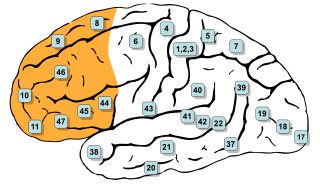
In mammalian brain anatomy, the prefrontal cortex (PFC) covers the front part of the frontal lobe of the cerebral cortex. It is the association cortex in the frontal lobe. The PFC contains the Brodmann areas BA8, BA9, BA10, BA11, BA12, BA13, BA14, BA24, BA25, BA32, BA44, BA45, BA46, and BA47.
Bilingualism, a subset of multilingualism, means having proficiency in two or more languages. A bilingual individual is traditionally defined as someone who understands and produces two or more languages on a regular basis. A bilingual individual's initial exposure to both languages may start in early childhood, e.g. before age 3, but exposure may also begin later in life, in monolingual or bilingual education. Equal proficiency in a bilingual individuals' languages is rarely seen as it typically varies by domain. For example, a bilingual individual may have greater proficiency for work-related terms in one language, and family-related terms in another language.

In cognitive science and neuropsychology, executive functions are a set of cognitive processes that are necessary for the cognitive control of behavior: selecting and successfully monitoring behaviors that facilitate the attainment of chosen goals. Executive functions include basic cognitive processes such as attentional control, cognitive inhibition, inhibitory control, working memory, and cognitive flexibility. Higher-order executive functions require the simultaneous use of multiple basic executive functions and include planning and fluid intelligence.

Mental rotation is the ability to rotate mental representations of two-dimensional and three-dimensional objects as it is related to the visual representation of such rotation within the human mind. There is a relationship between areas of the brain associated with perception and mental rotation. There could also be a relationship between the cognitive rate of spatial processing, general intelligence and mental rotation.
Perseveration, in the fields of psychology, psychiatry, and speech–language pathology, is the repetition of a particular response regardless of the absence or cessation of a stimulus. It is usually caused by a brain injury or other organic disorder. Symptoms include "lacking ability to transition or switch ideas appropriately with the social context, as evidenced by the repetition of words or gestures after they have ceased to be socially relevant or appropriate", or the "act or task of doing so", and are not better described as stereotypy.
Hot cognition is a hypothesis on motivated reasoning in which a person's thinking is influenced by their emotional state. Put simply, hot cognition is cognition coloured by emotion. Hot cognition contrasts with cold cognition, which implies cognitive processing of information that is independent of emotional involvement. Hot cognition is proposed to be associated with cognitive and physiological arousal, in which a person is more responsive to environmental factors. As it is automatic, rapid and led by emotion, hot cognition may consequently cause biased decision making. Hot cognition may arise, with varying degrees of strength, in politics, religion, and other sociopolitical contexts because of moral issues, which are inevitably tied to emotion. Hot cognition was initially proposed in 1963 by Robert P. Abelson. The idea became popular in the 1960s and the 1970s.
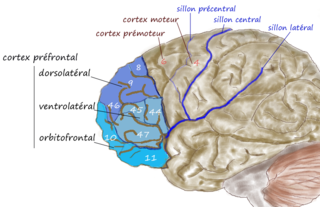
The dorsolateral prefrontal cortex is an area in the prefrontal cortex of the primate brain. It is one of the most recently derived parts of the human brain. It undergoes a prolonged period of maturation which lasts into adulthood. The DLPFC is not an anatomical structure, but rather a functional one. It lies in the middle frontal gyrus of humans. In macaque monkeys, it is around the principal sulcus. Other sources consider that DLPFC is attributed anatomically to BA 9 and 46 and BA 8, 9 and 10.
In psychology and neuroscience, executive dysfunction, or executive function deficit, is a disruption to the efficacy of the executive functions, which is a group of cognitive processes that regulate, control, and manage other cognitive processes. Executive dysfunction can refer to both neurocognitive deficits and behavioural symptoms. It is implicated in numerous psychopathologies and mental disorders, as well as short-term and long-term changes in non-clinical executive control. Executive dysfunction is the mechanism underlying ADHD paralysis, and in a broader context, it can encompass other cognitive difficulties like planning, organizing, initiating tasks and regulating emotions. It is a core characteristic of ADHD and can elucidate numerous other recognized symptoms.
The effects of sleep deprivation on cognitive performance are a broad range of impairments resulting from inadequate sleep, impacting attention, executive function and memory. An estimated 20% of adults or more have some form of sleep deprivation. It may come with insomnia or major depressive disorder, or indicate other mental disorders. The consequences can negatively affect the health, cognition, energy level and mood of a person and anyone around. It increases the risk of human error, especially with technology.
Task switching, or set-shifting, is an executive function that involves the ability to unconsciously shift attention between one task and another. In contrast, cognitive shifting is a very similar executive function, but it involves conscious change in attention. Together, these two functions are subcategories of the broader cognitive flexibility concept.

Inhibitory control, also known as response inhibition, is a cognitive process – and, more specifically, an executive function – that permits an individual to inhibit their impulses and natural, habitual, or dominant behavioral responses to stimuli in order to select a more appropriate behavior that is consistent with completing their goals. Self-control is an important aspect of inhibitory control. For example, successfully suppressing the natural behavioral response to eat cake when one is craving it while dieting requires the use of inhibitory control.

Attentional control, colloquially referred to as concentration, refers to an individual's capacity to choose what they pay attention to and what they ignore. It is also known as endogenous attention or executive attention. In lay terms, attentional control can be described as an individual's ability to concentrate. Primarily mediated by the frontal areas of the brain including the anterior cingulate cortex, attentional control and attentional shifting are thought to be closely related to other executive functions such as working memory.
Executive functions are a cognitive apparatus that controls and manages cognitive processes. Norman and Shallice (1980) proposed a model on executive functioning of attentional control that specifies how thought and action schemata become activated or suppressed for routine and non-routine circumstances. Schemas, or scripts, specify an individual's series of actions or thoughts under the influence of environmental conditions. Every stimulus condition turns on the activation of a response or schema. The initiation of appropriate schema under routine, well-learned situations is monitored by contention scheduling which laterally inhibits competing schemas for the control of cognitive apparatus. Under unique, non-routine procedures controls schema activation. The SAS is an executive monitoring system that oversees and controls contention scheduling by influencing schema activation probabilities and allowing for general strategies to be applied to novel problems or situations during automatic attentional processes.
Sex differences in cognition are widely studied in the current scientific literature. Biological and genetic differences in combination with environment and culture have resulted in the cognitive differences among males and females. Among biological factors, hormones such as testosterone and estrogen may play some role mediating these differences. Among differences of diverse mental and cognitive abilities, the largest or most well known are those relating to spatial abilities, social cognition and verbal skills and abilities.
